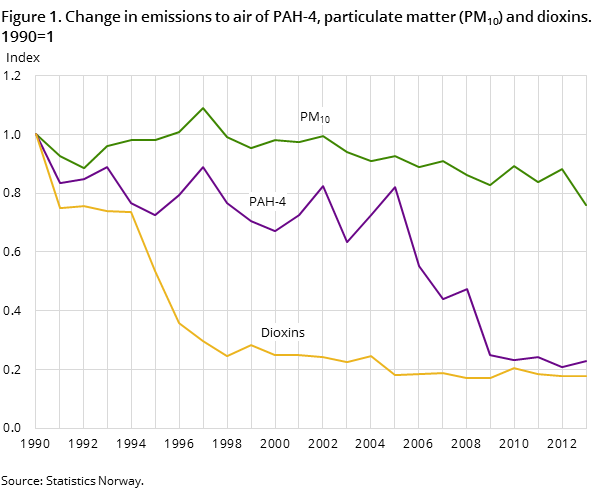Content
Published:
This is an archived release.
Reduced emissions of particulate matter
Emissions to air were practically the same in 2013 as in 2012 for most hazardous substances. Emissions of particulate matter decreased by 14 per cent, mainly due to a reduction in the use of fuel wood in private households.
| 2013 | Change in per cent | ||
|---|---|---|---|
| 2012 - 2013 | 1990 - 2013 | ||
| 1Does not include ocean transport and international air transport. | |||
| Lead (kg) | 5 507 | -1.3 | -97.1 |
| Cadmium (kg) | 475 | -7.9 | -68.5 |
| Mercury (kg) | 392 | -1.5 | -73.4 |
| Arsenic (kg) | 1 360 | 1.9 | -61.0 |
| Chromium (kg) | 2 973 | 14.7 | -76.7 |
| Copper (kg) | 28 479 | -2.0 | 11.1 |
| Particulates - PM10 (tonnes) | 38 403 | -13.8 | -24.0 |
| PAH-4 (kg) | 8 378 | 9.6 | -77.1 |
| Dioxins (g) | 21 | 0.2 | -82.1 |


The emissions of lead, mercury, copper, dioxins and arsenic were steady. The emissions of chromium and PAHs, (polycyclic aromatic hydrocarbons) increased from 2012 to 2013, while emissions of particulate matter (PM10) and cadmium decreased in 2013.
Reduction in most emissions since 1990
Emissions to air of several hazardous substances including PAHs (polycyclic aromatic hydrocarbons) have been considerably reduced since 1990. The cause of the decrease since 1990 is primarily reduced emissions within manufacturing and mining. Cleaning measures, changes in production procedures and lower activity in some industries have all resulted in reduced emissions.
Norway has a national target to reduce emissions compared with the emission levels in 1995. Internationally, we have an obligation to reduce emissions of selected hazardous substances compared with 1990.
Emissions of particulate matter decreased by 14 per cent
Emissions of particulate matter (PM10) were 38 400 tonnes in 2013, which is a 14 per cent decrease from 2012. Fifty per cent of the emissions of particulate matter (PM10) in 2013 came from wood-burning. The wood consumption decreased by 20 per cent from 2012 to 2013. At the same time, the calculated emissions of particulate matter from this source decreased by 21 per cent. This is due to a higher share of wood stoves with new technology. Process emissions from manufacturing and mining amounted to 8 700 tonnes, or 23 per cent of the emissions of particulate matter in 2013. Coastal navigation and fishing and emissions from oil and gas extraction were responsible for 5 and 4 per cent of the emissions respectively.
Steady emissions of most hazardous substances
In 2013, 5.5 tonnes of lead were emitted to air. Emissions from brake blocks are the dominant source for emissions to air of lead.
Emissions of mercury were 0.4 tonnes in 2013. Process emissions from metal production accounted for 14 per cent of the total mercury emissions to air in 2013. The most important sources of mercury emissions are manufacturing and mining and combustion without energy utility, which comprises cremations.
In 2013, 21 grams of dioxins were emitted to air. The most important emission source in 2013 was wood-burning in private households.
Emissions of copper were 28 tonnes in 2013. Copper emissions have decreased by 2 per cent since 2012. Emissions from brake blocks are the dominant source for emissions to air of copper.
In 2013, 1.4 tonnes of arsenic were emitted to air, which is a 2 per cent increase since 2012. For the past few years, the variation in arsenic emissions has been due to varying arsenic content in raw materials and reducing agents used in metal production. Emissions from manufacturing and mining accounted for more than 50 per cent of the total arsenic emissions to air in 2013.
Emissions of chromium were 3.0 tonnes in 2013, which is a 15 per cent increase since 2012. Combustion in chemical industry is the most dominant source of chromium emissions to air.
Emissions to air of cadmium totalled 0.5 tonnes in 2013. Cadmium emissions have decreased by 8 per cent since 2012 .Wood-burning in private households and combustion in the wood processing industry, mainly burning of refuse wood and waste liquor are the most important sources of emissions of cadmium to air. In 2012, these sources contributed with 23 and 12 per cent respectively.
Increased emissions of PAH-4
Process emissions in aluminium production are the most dominant source for PAH-4 emissions. These emissions have increased by 32 per cent since 2012, and contributed with 60 per cent of the total PAH-4 emissions to air in 2013. Road traffic made up 17 per cent of the emissions in 2013. This includes wear on roads, tyres and brakes.
Differences between emissions to air and local air quality Open and readClose
The figures calculated in these statistics are emissions to air, i.e. the amount of particulate matter coming from chimneys, exhaust pipes etc. This is not to be confused with local air quality or concentrations, which is the amount of substance that is actually inhaled by humans. In concentration calculations, the fact that humans are more exposed to some emission sources than others is taken into account. For instance, emissions from wood-burning are often emitted from chimneys, and do not affect local air quality to the same extent as exhaust emissions. For this reason, one tonne of particulate matter from wood-burning is less significant to concentrations at ground level than one tonne from exhaust.
The health risks associated with local air pollution depend on how high the concentration of the polluting substance is, and on length of exposure.
The statistics is published with Emissions to air.
Contact
-
Statistics Norway's Information Centre
E-mail: informasjon@ssb.no
tel.: (+47) 21 09 46 42
